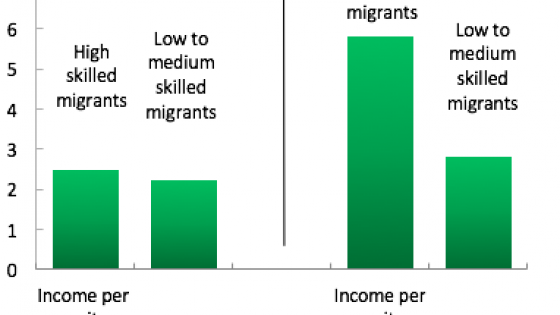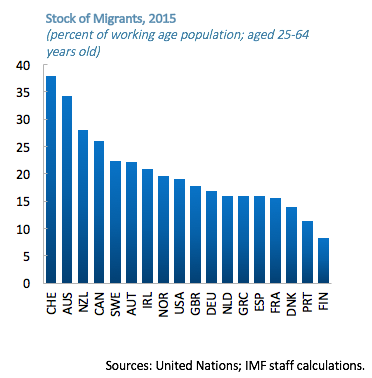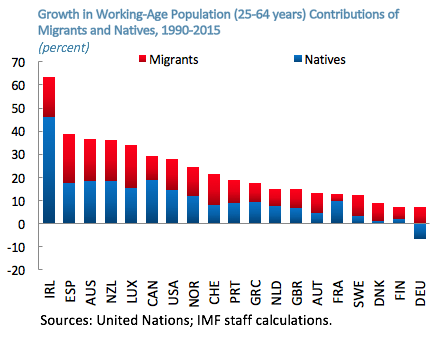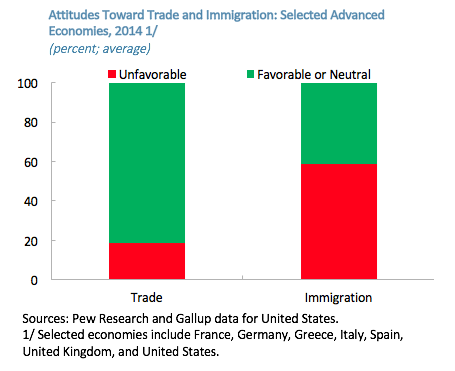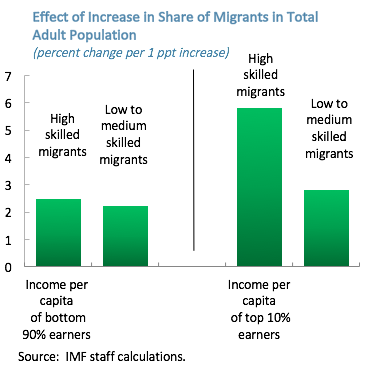While the recent surge in refugees has brought attention to migration issues, there is already a large population of migrants living in advanced economies, and migration continues to be on the rise. In many advanced economies, migrants constitute 15–20% of the adult population, and this number reaches 30% in some Anglo-Saxon countries. Migrants have accounted for half the growth in the working-age population of advanced economies between 1990 and 2015. And the UN projects that without further migration, the working-age population would decline in most advanced economies over the next 15 years, due to population ageing. These large numbers suggest that migrants can potentially have a significant impact on host economies.
Figure 1. Migrants and working age population, selected countries
Figure 2. Attitudes to trade and immigration
However, migration is a politically difficult issue and the rhetoric surrounding it has turned more negative in recent years. Public sentiment in advanced economies is actually much more negative when it comes to immigration than to trade. A careful examination of the impact of migration on host economies is thus critical.
Short-term pain, long-term gains
There are at least two potential reasons for the negative rhetoric. It has been argued that migrants can displace native workers in the labour market, or lower their wages. Most studies find only a limited effect of migration on the average wages and employment of native workers (for a survey, see Peri 2014). However, some find a negative impact on the wages of low-skilled workers (e.g., Borjas 2003, Card 2001). Migration has also been associated with social tensions – in part related to differences in culture and language – when migrants find it difficult to integrate in the labour market and in society. In Europe, surveys show that personal concerns over the compositional effects of migration – such as language and culture – matter much more to people than economic concerns such as jobs (Card et al 2012).
Much less is known, however, about the impact of immigration on the long-term prosperity of receiving economies, as measured by GDP per capita. This impact can go through two channels. First, as migrants are mostly of working age, migration increases the share of working-age population. If migrants are integrated in the labour market and are employed productively, this can boost GDP per capita. Second (and much less discussed), migration can also affect labour productivity. On the one hand, immigration can lower labour productivity, at least initially, as the entry of new labour reduces the available physical capital per worker, or if migrants are less educated on average than natives. On the other hand, the microeconomic literature suggests that migrants can increase productivity by increasing the diversity of skills and ideas, fostering skill complementarity and specialisation, and encouraging the upgrading of natives’ skills.
In a new paper, we examine the long-term effects of immigration at the macro level, specifically on the GDP per capita and labour productivity of receiving advanced economies (Jaumotte et al. 2016). Two earlier, broad cross-country studies found that immigration has a large effect on both income per capita and productivity (Ortega and Peri 2014, Alesina et al 2016). Compared with these studies, our research makes three contributions. First, it focuses exclusively on advanced economies, rather than a mixed sample of higher- and lower-income host countries. This provides results directly relevant for advanced economies, where the number of migrants has been larger relative to the native population and income levels are higher.[1] Second, we examine whether the GDP per capita impact varies for different skill levels of migrants, using a new panel database that provides the number of migrants by country of origin and education level for 18 advanced economies at five-year intervals during 1980–2010. Last but not least, we go beyond the aggregate impact of migration on GDP per capita to examine how broadly the gains are shared across the population.
Migrants increase GDP per capita and productivity
Identifying the effect of immigration on GDP per capita at the macroeconomic level is difficult due to endogeneity issues. For instance, a positive relationship could reflect the fact that high incomes in advanced economies attract migrants rather than migrants contributing positively to GDP per capita. To address the risk of reverse causality and other biases, we follow Ortega and Peri (2014) and Alesina et al. (2016) and construct an instrumental variable for the aggregate migration share using a gravity-type model and data on bilateral migration stocks. The model predicts migration based solely on factors which are largely exogenous to the host economies’ income levels. These factors include ‘push’ factors, which capture economic and political conditions in source countries, and geography- and culture-based costs of migration between host and source countries.
We find that migrants help increase per capita income levels in host advanced economies, and this effect is both statistically and economically significant. Our estimates suggest that a one percentage point increase in the share of migrants in the adult population (the average annual increase is 0.2 percentage point) can raise GDP per capita by up to 2% in the long run. Moreover, this effect comes mainly through an increase in labour productivity and, to a lesser extent, through the more standard channel of an increase in the ratio of working-age to total population.
The result survives a number of robustness checks, which include controlling for other determinants of income per capita (trade openness, the level of technology, the education level, and age structure of the host population, and policy variables); excluding from the sample countries that were created through migration and have high income levels (USA, Canada, Australia, and New Zealand); and using alternative gravity model-based instruments.
Both high- and low-skill migrants help
We find that both high- and low-skill migrants raise labour productivity. There is no evidence of major physical or human capital dilution, as investment adjusts over time to the larger pool of workers, and migrants are increasingly high-skilled. Instead, our results suggest that the complementarities that earlier analyses uncovered mostly at the micro level are also relevant at the macro level. The evidence from the microeconomic literature suggests that the positive productivity effects come from increased TFP and human capital. High-skilled migrants contribute to productivity directly, including through innovation, and indirectly through their positive spillovers on native workers. Low- and medium-skilled migrants can also contribute to aggregate productivity, to the extent that their skills are complementary to those of natives, promoting occupational reallocation and task specialisation. For instance:
- Migrants can take jobs in sectors for which natives are in short supply, such as in agriculture, nursing, housekeeping, and landscaping. Without migrants, natives would have to be incentivised to provide these essential services, and the result would be lower supply at higher cost.
- When migrants take up more manual routine jobs, natives move to perform more complex tasks (associated with abstract and communication skills), which promotes their skill upgrading (D’Amuri and Peri 2014).
- Last but not least, there are complementarities between low-skilled migrants and high-skilled native females. In fact, we find empirical support for this so-called ‘nanny effect’ – when help from low-skilled migrants is available – through greater availability of childcare and household services, then native women – especially those with higher skills – increase their labour supply (Cortés and Tessada 2011).
Figure 3. Effect of increase in migrant share in total adult population
Gains are broadly shared
An increase in average income per capita does not necessarily guarantee that the broad population is better off. If all the income gains were captured by companies’ top executives and shareholders, the broad population might not benefit and could actually be worse off. Our analysis finds, however, that the gains from immigration are broadly shared across the population. Migration increases the average income per capita of both the bottom 90% and the top 10% of earners, even though high-skilled migration benefits more top earners — possibly because of a stronger synergy between migrants and natives with high skills. Moreover, the Gini coefficient — a broad measure of income inequality within the bottom 90% of earners — is not affected by the migrant share.
Policy implications
While migration may come with short-term costs – for example, to foster the labour market integration of refugees – our study shows that it might be worth shouldering these to reap long-term benefits of increased income levels and prosperity.
The policies that help migrants integrate faster include language training, job search support, better recognition of their education and work experience, and lower barriers to entrepreneurship (Aiyar et al 2016). While these policies may require additional public spending, they allow migrants to obtain a job, increasingly contribute to the fiscal accounts, and aid the long-term increase in GDP per capita.
At the same time, while the benefits from migration seem to be broadly shared, some native workers, too, may require help adjusting, for example by upgrading their skills. Policymakers also need to avoid a possible overburdening of public services such as health care and education to contain a possible build-up of social tensions.
Editor’s note: The views expressed herein are those of the authors and should not be attributed to the IMF, its Executive Board, or its management.
References
Aiyar, S, B Barkbu, N Batini, H Berger, E Detragiache, A Dizioli, C Ebeke, H Lin, L Kaltani, S Sosa, A Spilimbergo and P Topalova (2016) “The refugee surge in Europe: Economic challenges”, IMF Staff Discussion Note 16/02, Washington: International Monetary Fund.
Aleksynska, M and A Tritah (2015) “The heterogeneity of immigrants, host countries’ income and productivity: A channel accounting approach”, Economic Inquiry, 53(1): 150-172.
Alesina, A, J Harnoss and H Rapoport (2016) “Birthplace diversity and economic prosperity”, Journal of Economic Growth, 21(2): 101–38.
Borjas, G J (2003) “The labor demand curve is downward sloping: Reexamining the impact of immigration on the labor market”, Quarterly Journal of Economics, 118(4): 1335–74.
Card, D (2001) “Immigrant inflows, native outflows, and the local market impacts of higher immigration”, Journal of Labor Economics, 19(1): 22–64.
Cortés, P and J Tessada (2011) “Low-skilled immigration and the labor supply of highly skilled women”, American Economic Journal: Applied Economics, 3(3): 88–123.
D’Amuri, F and G Peri (2014) “Immigration, jobs, and employment protection: Evidence from Europe before and during the Great Recession”, Journal of the European Economic Association, 12(2): 432–64.
Jaumotte, F, K Koloskova and S Saxena (2016) “Impact of migration on income levels in advanced economies”, IMF Spillover Note, Issue 8, October.
Ortega, F and G Peri (2014) “Openness and income: The role of trade and migration”, Journal of International Economics, 92(2): 231–51.
Peri, G (2014) “Do immigrant workers depress the wages of native workers?”, IZA World of Labor.
Endnotes
[1] Looking at OECD countries, Aleksynska and Tritah (2015) also found a positive effect of immigration on income per capita and productivity of host countries, especially for prime-age immigrants.
